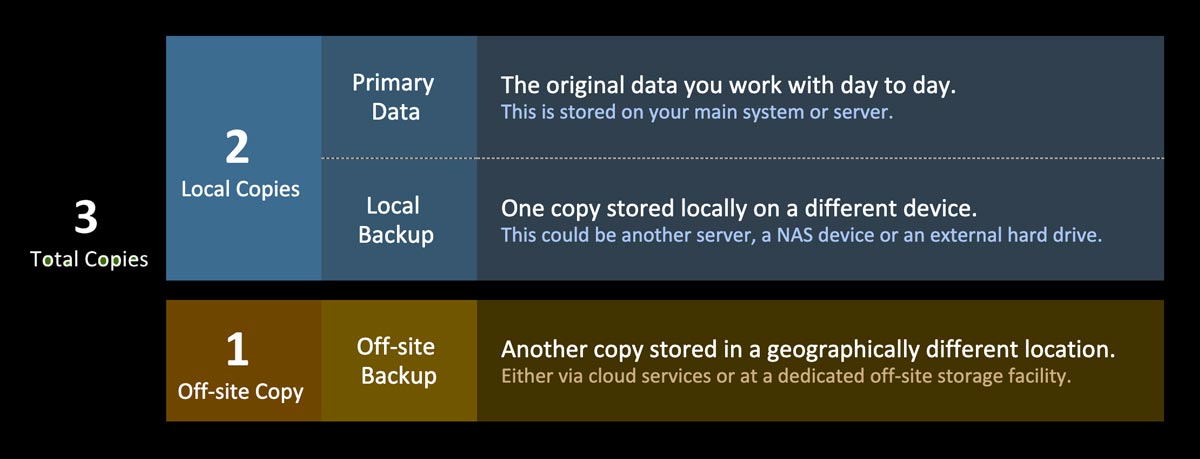What is the 3-2-1 Backup Rule?
Organizations need to have backups to keep their data safe and ready to be restored in case something goes wrong, like a computer failure or a hacking incident.
A good backup system helps companies bounce back quickly, keep their operations running smoothly and ensure they don’t lose valuable information.
The 3-2-1 backup strategy is widely endorsed by IT experts and leading organizations in the industry. It’s straightforward yet effective — maintain three total copies of your data, keep two on different platforms to avoid a single point of failure with one of them stored off-site for additional security against local or floods.
“The 3-2-1 rule is designed to protect against a wide array of potential threats to data integrity, including hardware failure, software corruption, human error, theft and natural disasters.”
- 3 total copies of your data
- Primary Data: The production data you are actively working with day to day.
- Local Backup: One copy stored locally but on a different device from your primary data.
- Off-site Backup: Another copy stored in a geographically different location.
- 2 copies stored on different platforms
- Two copies stored locally but on different physical devices.
- One “copy” is your primary data stored on your main system or server
- The other copy is stored on a different physical device such as a secondary server, network-attached storage device or external hard drive.
- 1 copy stored off-site
- The last copy is stored in a geographically different location, either via cloud services or at a dedicated off-site storage facility.

Why Utilize 3-2-1 Backup Rule?
The 3-2-1 backup rule is broadly used for a few reasons:
- Comprehensive risk mitigation: The 3-2-1 rule is designed to protect against a wide array of potential threats to data integrity, including hardware failure, software corruption, human error, theft and natural disasters. By spreading risk across different mediums and locations, it significantly reduces the chance that a single event could compromise all copies of the data.
- Simplicity and accessibility: Despite its robustness, the 3-2-1 strategy is relatively simple to understand and implement. It does not require specialized knowledge beyond basic backup practices, making it accessible to organizations of all sizes. This simplicity encourages widespread adoption, ensuring that critical data is protected even in smaller operations that might not have dedicated IT support.
- Cost-effectiveness: While implementing a 3-2-1 strategy involves initial setup and ongoing maintenance costs, it can be far more cost-effective than the potential losses associated with significant data breaches or loss incidents. The cost of data loss not only includes the immediate financial impact but also long-term reputational damage, loss of customer trust and potential legal ramifications.
The 3-2-1 backup rule is a great starting point, but it doesn’t explicitly protect you from ransomware or attacks that try to take advantage of anything on your network.
In a future post, we will discuss why the technology division of Hungerford goes even further with the 3-2-1-1-0 backup rule that specifically protects against ransomware attacks and ensures that your backups are free from errors that could stop you from being able to successfully restore from backup when you need it.
West Michigan IT Services
Are you looking to improve backup protocols for your organization? Contact us here to see how we can help keep your business running smoothly while increasing productivity, security and profitability.
Did you like this blog? You can subscribe to our newsletter to receive a weekly email with our latest blog posts.











